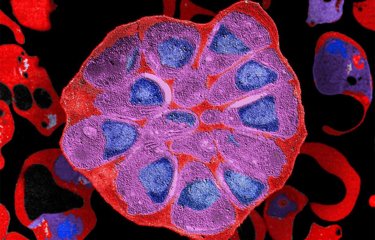A team from the Pasteur Institute has just uncovered a subtle mechanism used by the parasite that is responsible for malaria to escape from the immune system during a crucial stage of its cycle inside its mammalian host. This has been made possible thanks to in vivo imaging techniques that make it possible to follow the parasite in real time inside the host organism. This discovery - published in the journal Science - points towards new therapeutic targets against the disease that causes at least 500 million cases and a million deaths per year.
Press release
Paris, september 1st, 2006
The first stage of the life cycle of the malaria parasite takes place in the liver. After the mosquito bite, the parasite in the form of a sporozoite enters the organ through the blood flow, and differentiates in the hepatic cells into an invasive form that is called a merozoite. It is this form which invades the red blood cells and causes the subsequent onset of the disease symptoms.
Up till now, it was assumed that merozoites were leaving the liver individually to reach the blood flow; the way they subsequently escaped the immune system, in particular the many macrophages that roam around the liver, remained an enigma.
The team of Robert Ménard, unit manager of biology and genetics of malaria at the Pasteur Institute, in collaboration with the researchers at the Institute of Tropical Medicine under Bernhard Nocht in Hamburg, have just solved the mystery.
They used in vivo imaging techniques that they have been developing over the past few years, which enable them to follow the fluorescent parasites in real-time in a rodent model. The researchers discovered that merozoites used a Trojan Horse strategy to leave the liver and enter the blood stream "incognito".
They observed that the infected hepatic cells - each containing 10 000 merozoites -, although dead, gave rise to buds that the researchers called merosomes. These merosomes/Trojan horses crammed with parasites entered the sinusoid vessels of the liver then broke out into the blood stream where the merozoites were released.
The parasites appear able to guide their vehicle and mask it. As it comes from dead cells, the membrane of the merosomes should actually send signals to induce their own degradation process so that the macrophages/refuse collectors can swallow up and destroy the undesirable structure. This very typical signal sent by all cells to start off the degradation process is no longer exposed on the surface of the merosomes thanks to the biochemical changes set off by the parasite.
Updated information on these mechanisms, in addition to better understanding of the malaria infection, offer new therapeutic targets all the more interesting because they play an essential role in the parasite’s life before the parasite causes the symptoms (invasion of the red blood cells).
"In vivo imaging has proven to be an extraordinary tool to improve our understanding of the infection mechanism," says Robert Ménard emphatically. "It should make it possible in the future to pinpoint new therapeutic targets both for malaria and other infectious diseases."
Sources :
"Malaria parasites manipulate host hepatocytes for their safe delivery into liver sinusoids": Science, September 1, 2006.
Angelika Sturm (1), Rogerio Amino (2,3), Claudia van de Sand (1), Tommy Regen (1), Silke Retzlaff (1), Andreas Krueger (1), Jörg-Matthias Pollok (4), Robert Ménard (2), Volker T. Heussler (1)
1. Bernhard Nocht Institute for Tropical Medicine, Hamburg, Germany
2. Parasitology Department, Pasteur Institute, Paris
3. Department of Biochemistry, Federal University of Sao Paulo, Brazil
4. Department of Hepatobiliary Surgery, University Hospital Hamburg-Eppendorf, Hamburg, Germany
Contact press :
Institut Pasteur Press Office
Nadine Peyrolo ou Corinne Jamma,
01 40 61 33 41 - cjamma@pasteur.fr
The Pasteur Institute is a non-profit-making private foundation dedicated to biomedical research, public health and teaching. Almost 2600 people work on the campus in Paris where a large part of the research is targeted towards infectious diseases.






